Matthew Houde's Blog, page 30
January 13, 2016
Crossing the Rio Sereno Border Between Costa Rica and Panama
Two Weeks in Costa Rica |
If you plan on traveling to Costa Rica’s neighboring countries by foot, bus, or car, you’ll want to know about its border crossings. Costa Rica has several borders or fronteras connecting it to Nicaragua to the north and Panama to the south. We’ve crossed several of these borders during our time in Costa Rica. They’re typically hectic and crowded, with lines of people queued up, and are dusty, hot, and uninviting. While they do share certain similarities, each border is set up a little differently so it takes some time to figure out where to go and what to do.
We recently did the Rio Sereno border crossing in southern Costa Rica and were pleasantly surprised by the experience. In this post, we’ll share what you need to know to get ready to cross this little-known border.

Location
The Rio Sereno border is located in the mountains of southern Costa Rica. The closest major town on the Costa Rica side is San Vito, a rural community with a small-town feel that is best known for hosting the Wilson Botanical Gardens. The San Vito area is also a birding hotspot, complete with a local birding club. On the Panama side, the closest major town is Volcan, and the city of David is a couple of hours away.
For recommendations on places to stay near the border, check out the bottom of this post.
Border Crossing Process
What You’ll Need
Note: The requirements sometimes change. We’ll try to update this post if they do, but as of January 2016, this is what is required.
2 copies of your passport (photo/ID page)
Proof of onward travel (plane ticket)
$500 or bank statements or a credit card to show proof of sufficient funds (3 months)
$8 to pay Costa Rica’s exit tax. Payable in Colones as well.
Pen to fill out Costa Rica’s immigration form.
Set-up
The first thing you’ll notice about the Rio Sereno border is how quiet it is. You won’t find the traffic, lines of tractor trailers, and crowds of people here that you see every day at the busy Paso Canoas border, one of Costa Rica’s other border crossings with Panama. At Rio Sereno, there are just few government buildings, a grocery store, and a couple of other small stores and duty free shops spread out along the dirt road.

Main road running through the border
Here’s a map to help you get your bearings. The three buildings that you will need to visit are all within a few minutes’ walk from one another.
For directions to the border, see the bottom of this post.

Exiting Costa Rica and Entering Panama
The first thing you’ll need to do is get your exit stamp from Costa Rica. Here’s a breakdown of the process:
Pay departure tax: Costa Rica has a tax (impuesto) that must be paid before you can exit the country by land. Everyone crossing on foot or by car or bus has to pay this tax. You can pay it at certain banks in Costa Rica in advance, but the easiest way to do it is right at the border. Look for the Agroquimicos store on the right as you come into the border area, after the government buildings and next to the grocery store. The tax is $8. They’ll give you a receipt that you can put in your passport for when you check out of Costa Rica.

Agroquimicos store where you pay Costa Rica exit tax
Check out of Costa Rica: Once you’ve paid the exit tax, head back up the small hill to the Costa Rica Migration office. It’s one of the first buildings on the left as you come into the border area. It’s a makeshift-looking building with a corrugated metal roof and a sign that says Oficina Reg. Sabalito. You can enter from the open area in the front or back. Note: This is a separate building from the Costa Rica police station.
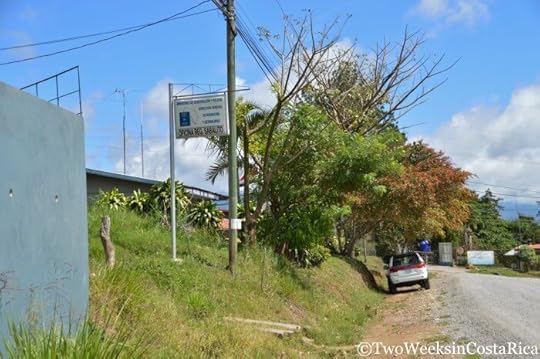
Costa Rica Migration Office, view from main road
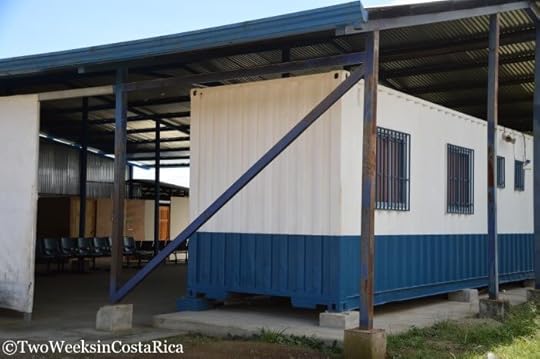
Costa Rica Migration Office, view from back
There will be a large open space and some chairs, though there’s not likely to be any line as this border crossing usually isn’t very busy. The immigration official will ask you for your passport and have you fill out a form where you put basic information like your name, passport number, destination, etc. Usually the agent doesn’t ask too many questions but we’ve been asked where we’re traveling, for how long, and if we’re going by car. Once the agent has gone through your paperwork, he or she will put an exit stamp in your passport.
Note that if you’re bringing your car across the border, there is another whole process for getting the permissions and paying insurance.
Get stamped into Panama: Once you have your exit stamp, head a couple hundred meters down the street to the Panama Migration office. It’s the green building with the red roof. Look for the Panama flag and a yellow sign that says Migracion.
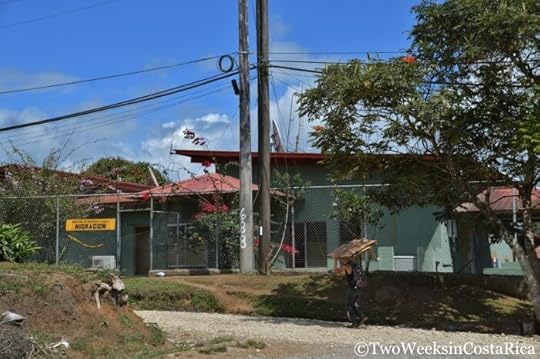
Panama Migration Office
When you enter the building, go to the office on the left. If there is a line, wait on the right side of the entranceway under the sign “entrada/salida.” The line on the left is for “grupos originarios” or indigenous travelers, which require different paperwork. This area of both countries has several indigenous communities so you will likely see them waiting around town, dressed in colorful dresses.
Once in the office, the immigration agent will take your passport. There isn’t a form to fill out, but the agent will likely ask where you’re traveling to and for how long. They will probably also ask for a copy of your passport and proof of $500 (usually can be satisfied by showing 3 months’ of bank statements or a valid credit card if you don’t want to carry cash). We weren’t asked to show $500 but it’s best to be ready to do so. If you don’t have a copy of your passport, you can have one made at the Libreria (office supply store) next to the Agroquimicos store.
The last requirement is to show proof of onward travel out of Panama within 180 days. This requirement has changed over the years and even differs by border. Bus tickets out of the country sometimes work, but lately Panama has been requiring a plane ticket back to your home country (country that issued your passport). At Rio Sereno, we were asked for our plane tickets and gave them our tickets from Costa Rica to the US.
The agent will then stamp your passport and you’re ready to travel to Panama. Standard visas are for 180 days.
Exiting Panama and Entering Costa Rica
If you’re returning to Costa Rica after your visit to Panama, you’ll just go through the process in reverse.
Get stamped out of Panama: Go to the same office and get stamped out of Panama. This is usually a very straightforward process and there are no fees. We weren’t asked any questions other than for a copy of our passports.
Get stamped into Costa Rica: Go back to the Costa Rica Migration office. They’ll have you fill out the same form you did before. Costa Rica requires proof of onward travel out of the country through a plane ticket back to your home country within 90 days. We were asked for this ticket and also where we were going in Costa Rica. Standard visas are 90 days, but the exact amount is up to the discretion of the immigration official.
Directions from Costa Rica
Getting to San Vito and then on to Sabalito is fairly straightforward, but the road to the border isn’t well marked. Once you enter downtown Sabalito, you’ll pass some small stores and restaurants and then come to an intersection with a road going to the left (near the gas station). Continue straight/right on the main road, passing the supermarket BM on the right. In about 50 meters, as you go up a small hill, you’ll see a large sign on the right that says Zona Comercial 5 Esquinas. Take the dirt road on the left across the street and follow it all the way to the border (about 5-10 minutes). There are a few twists and turns but it is easy to tell which dirt road is the main one. It is bigger and in better condition than the offshoots.

Where to Stay
If you’re looking for a place to stay on the Costa Rica side, San Vito is a good option. It has several local restaurants (and some good Italian ones), grocery stores, and shops in the busy downtown. The downtown also offers some inexpensive hotels, and on the outskirts of town are a few bed and breakfasts. Hotel Cascata del Bosco and Casa Botania are two charming B&Bs that are just a short drive from the Wilson Botanical Gardens. The town of Sabalito, closer to the border, also has a few simple accommodations if you’re getting in very late, like Cabinas Talinda.
On the Panama side, one of the closest towns is Volcan, about 45 minutes from the border. Volcan is near the Baru Volcano, Panama’s highest peak, and is great for outdoors’ enthusiasts. It is often compared to the popular town of Boquete, but is less developed and more reasonably priced. If you’re looking for lodging near Volcan, a couple of good options are Cielito Sur Bed & Breakfast Inn in Cerro Punta, close to the volcano, and Hostal Victoria Volcan Chiriqui, a budget hotel located in the downtown.
If you’re looking to avoid the busy Paso Canoas border, we highly recommend the Rio Sereno border crossing. In addition to being much easier to navigate, the Rio Sereno border is nice because it’s close to the picturesque town of San Vito and the beautiful landscapes of Costa Rica’s southern zone.
Have you done this border crossing recently? Leave a comment below with your experience to help other travelers know what to expect.
Some of the links in this post are affiliate links. If you book a hotel using one of the links, we receive a small commission at no extra cost to you. Read our Privacy Policy for more information.
The post Crossing the Rio Sereno Border Between Costa Rica and Panama appeared first on Two Weeks in Costa Rica.
January 6, 2016
The Whale Tail at Uvita’s Marino Ballena National Park
Two Weeks in Costa Rica |
Nature works in mysterious ways. And one really interesting oddity of nature is the so called whale tail that juts into the Pacific Ocean on Costa Rica’s Southern Pacific Coast. This giant rock and sand formation not only has the distinct shape of a whale’s tail, but is located in the exact spot where hundreds of humpback whales congregate each year. In this post, we’ll let you know how to see this famed whale beacon for yourself.

About the Whale Tail
Costa Rica’s famous whale tail is located in the small town of Uvita, about an hour south of Manuel Antonio and is part of Parque Nacional Marino Ballena (the National Marine Whale Park). This national park, one of only two national marine parks in the country, consists of 270 protected land acres (110 hectares) and 13,200 acres (5,375 hectares) of preserved ocean. The delicate ecosystems that the park protects include things like mangroves, coral reefs, beaches, and whale-breeding grounds. The whale tail itself is a result of converging currents. These currents deposit sand on top of the rock formations to create the unique, tail-shaped pattern.
If you are planning a visit, the greater area is known as the Costa Ballena (Whale Coast) and consists of three towns, Dominical, Uvita, and Ojochal. For more information about this stretch of coastline, including some hotel and activity recommendations, check out our post all about it.
Access
The cool thing about Uvita’s whale tail is that it can be enjoyed from many different vantage points. Here are the three best ones:
The Bird’s Eye View
The first way to enjoy the whale tail is from above. Although some people might catch a glimpse if they are flying on a small plane to or from Drake Bay or Puerto Jimenez (see cover photo) on the Osa Peninsula, an easier way is to just drive into the hills. Since the Costa Ballena region has steep mountains very close to the ocean, you can see the fin-shaped sandbar from the balconies of many vacation rentals, hotels and B&Bs, or even from different spots along mountain roads. One easy place to see it is from the dirt road near Rancho La Merced (on the highway just north of Uvita). This long dirt road (4×4 required) eventually leads up to a village called San Josecito. But only a few minutes’ drive up the mountain, there is this gorgeous view.

View from the road to San Josecito, north of Uvita.
Visiting the National Marine Park
Another way to enjoy the whale tail is to get up close and actually walk out onto the rocks and sand that make up the tail. This can be done only at lower tides, so check the charts to see what time you should go. To do this, you will have to pay admission at Marino Ballena National Park ($6 foreigners, ₡1,000 nationals) and walk from the main entrance in Uvita’s Bahia neighborhood. The park has three other entrances, on three different beaches, so be sure to start out from the right place at Playa Uvita. It only takes about 15-20 minutes to reach the point from the ranger station, but be forewarned, it can be extremely hot. There is absolutely no shade, so make sure to take a bottle of water and wear proper sun protection. For footwear, navigating on the uneven rocks can be tricky, and although we did it in flip-flops, it would be much easier in sturdy sandals or sneakers.
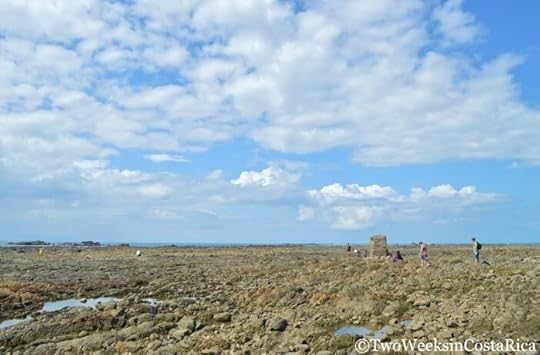
Walking on the rocks can get a little treacherous so take your time.
From the tip of the whale tail, you can explore the thousands of little tide pools and rock formations that are normally covered at high tide. When we’ve gone out, we have seen all kinds of small fish, snails, and crabs in these pools. Some people even snorkel in the adjacent waters if conditions are good, but we haven’t been lucky enough to time it just right. In our opinion, though, the best part of visiting the tip of the whale tail is to look back to shore and take in the amazing mountain and beach views that make this area of Costa Rica so special.
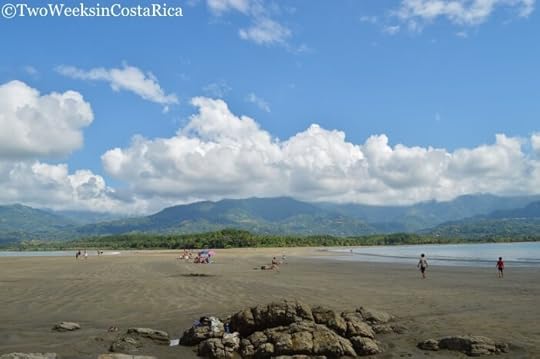
Nothing like a palm-tree-lined coast with jungle-filled mountains as a backdrop.
Go by Sea
A third way to enjoy the whale tail is to get out on the water. If you enjoyed the view from the tip of the tail, you’ll love the vantage point you can get from farther out in the ocean.
There are a few different options for this experience: One is to take a whale watching tour from Uvita. These tours will take you around the tip of the tail and to some of the small offshore islands nearby. The whales come for about nine months a year, so make sure to time it right. We wrote a whole post about this, so if you are interested, you can read it here (Whale Watching in Costa Rica).

A shot we took while whale watching near the tail.
Other tours out of Uvita include kayak and stand up paddle-boarding (SUP), which also go out around the tip of the tail and the islands. Or, for a glimpse under the water, take a diving or snorkeling tour. This area has a ton of underwater rock formations that are perfect for exploring. Tip: Be sure to inquire about visibility before booking a snorkel or dive tour as the water around the whale tail sometimes can be murky.
Uvita’s whale tail is a unique natural phenomenon that you won’t want to miss when visiting the Costa Ballena region of Costa Rica. When we first explored this area of Costa Rica back in 2007, we fell in love with it. Now we live close by! We’ll never forget trekking out to the tip of the whale tail for the first time, totally unprepared and sunburned, but in awe of the raw beauty of the ocean and lush green mountains. Hopefully this post will get you ready for your own adventure, and you’ll love it just as much as we do.
Have a question about visiting the Costa Ballena? Ask it below.
Looking for more information about this region of Costa Rica? Check out these posts:
7 Things to Do in Dominical – Our top picks for activities in the surf town of Dominical, just north of Uvita.
Visiting the Beautiful Nauyaca Waterfalls – Tips for hiking to one of our favorite waterfalls.
Costa Rica Rental Car Discount – The Costa Ballena is more remote and best accessed with a rental car. Check out our discount to save some money.
The post The Whale Tail at Uvita’s Marino Ballena National Park appeared first on Two Weeks in Costa Rica.
December 30, 2015
Viento Fresco Waterfalls: A Refreshing Stop Between La Fortuna and Monteverde
Two Weeks in Costa Rica |
La Fortuna and Monteverde are two of Costa Rica’s top destinations, and many people visiting one will often travel to the other. But those who have driven this beautiful but bumpy stretch before know that there is not much around besides the occasional farmhouse or herd of cows. Luckily, there is one place worth a visit, the Viento Fresco Waterfalls. In this post, we’ll give you all the details you need to plan a refreshing stop at this set of four peaceful waterfalls.

Location
The Viento Fresco Waterfalls are located 11 km (7 miles) from the city of Tilaran. They are roughly halfway between the popular destinations of La Fortuna and Monteverde, or a little less than two hours from La Fortuna and 1-1.5 hours from Monteverde.
Tip: The section of road between Tilaran and Monteverde (Route 145) is mostly dirt and changes conditions at different times of year. Sometimes it can be fairly smooth, but other times, it can have large potholes, washouts, or muddy ruts. We recommend a vehicle with higher clearance and 4×4 so that you don’t have any problems. Four-wheel-drive cars are more expensive but the peace of mind and comfort (for the bumps) is worth the extra cost. Check out our rental car discount to help save.

Road conditions on Route 145 between La Fortuna and Monteverde during the dry season.
Access
Access to the Viento Fresco Waterfalls is easy. Right off the main road (Route 145), you will see signs for the office/restaurant and the falls. After you pay the admission fee ($15 foreigners, ₡3,000 nationals), you will be given a map and can drive your car to the nearby trailhead where there is another small parking lot and bathroom. Note that the dirt road to the trailhead can be bumpy and uneven, so again, a vehicle with higher clearance is best.
From that area, there are a series of rustic steps and paths that lead down through the forest and some fields to the different waterfalls. The hike is easy to moderate, but be warned that there are at least 400 steps by our count. So if you are stopping here to stretch your legs, you will definitely get some exercise. Plan for about one to two hours total to enjoy the property.
See below for a map of the area. To see a map of the trail and waterfalls, click here.
Note: With a little advanced planning, you can also arrange to visit the waterfalls by horseback tour ($55), but you will still have to traverse the steps to see some of the falls. Horseback tours take about three hours. Viento Fresco also has an onsite restaurant and some camping areas. See their website for more info.
The Waterfalls
Walking down the steps from the parking area, it doesn’t take long to reach the first waterfall, the Serena River Waterfall. This cascade drops 102 feet (31 meters) into a nice pool. There is a small bathroom here where you can change into your swimsuit. Since it was a little chilly in the shade of the forest, we decided to keep hiking to find the other falls.

Serena River Waterfall
Tip: Viento fresco translates to “cool wind” and you will notice that the breeze coming across the mountains is definitely refreshing. Depending on the weather, it might feel a little cold for swimming.
Continuing down the path and steps through the forest, there is a nice open spot called the lookout, which gives you a great view of the mountains and one of the waterfalls in the distance.

View from the Lookout. This view is similar to ones you will see all along the road between Monteverde and La Fortuna.
From the lookout, a short separate trail leads to the Hidden Waterfall. Although not as tall as the Serena at only 66 feet (20 meters), the Hidden Waterfall has a lot of character. At the top is a big boulder that looks like it is about to get pushed off the edge by the water pressure, and below are shallow caves on each side that make it look like a spooky face or set of eyes.

Hidden Waterfall
After getting back up to the lookout, it is another good climb down to the next waterfall. At the base of the hill, the trees give way to a flatter more open area. This is where you’ll see the Rainbow Waterfall, the tallest single drop on the property at 247 feet (75 meters). This waterfall was our favorite because the water just cascades through mid-air in wispy sheets before landing on the rocks below. The mist coming off can sometimes create a rainbow (although we didn’t see one) and helps grow the colorful moss on the surrounding rocks. Since it is more open and sunny at the Rainbow Waterfall, some people like to wade in the pool and shower under the falls. There is a changing room here where we got into our swimsuits, but we decided we’d wait for the last waterfall to actually get wet.

Rainbow Waterfall
Although the trail is more open and a lot flatter, the last waterfall is a good ten minute walk downhill of the Rainbow Waterfall. The effort is worth it, though, because the Slide Waterfall is 312 feet tall (95 meters), and as the name implies, it literally slides down the side of the mountain. The rugged rocks on the slope make the water go in all different directions and create several shallow pools at the base. This is where we decided to get wet, especially since we had just hiked through the sunniest part of the trail. The great thing about the Slide Waterfall was that the rocky areas were fairly mud free, unlike some of the pools at the previous falls. This way we could get right under the streams of water without wading through any murky pools.

Slide Waterfall
After showering off at the Slide and taking in the spectacular views, we headed back up the hill to the parking area. The hike up was a little rough with all the steps, and by the time we made it, we were ready to get back in the car and continue down the road. We definitely recommend Viento Fresco Waterfalls as a pit stop to break up the long ride between Monteverde and La Fortuna. Just make sure whoever is behind the wheel gets a coffee or smoothie to recharge before they drive the rest of the way.
Have you visited the Viento Fresco Waterfalls? Let us know your thoughts in the comments below.
Looking for more info to plan your trip? You might like these posts:
Driving in Costa Rica: What to Know Before You Go – Packed with info that you might need before getting behind the wheel.
6 Great Eats Around Lake Arenal – If you’re making the drive between La Fortuna and Monteverde, don’t miss these great restaurants and brewery.
La Fortuna: What to Expect from Costa Rica’s Most Popular Destination – Everything you need to know about La Fortuna, the closest town to Arenal Volcano. Includes activities, hotels, restaurants, and more.
The post Viento Fresco Waterfalls: A Refreshing Stop Between La Fortuna and Monteverde appeared first on Two Weeks in Costa Rica.
December 16, 2015
Where to Buy Baby Stuff in Costa Rica
Two Weeks in Costa Rica |
We’ve mentioned in the past about how it can be difficult to find certain items in Costa Rica. Up until this point, this has been fine. With just the two of us, we’ve made it work with what is available locally or if we really needed something, we’ve had friends or family visiting from the United States bring it. Having a baby, however, has presented a whole new set of challenges. Although we don’t want a house cluttered with baby stuff and are trying to be as minimalist as possible, the fact is that babies need certain things and you can’t do much to get around it. Here are our tips for buying baby items in Costa Rica.

Where You Live Matters
One thing to keep in mind is that where you live in Costa Rica makes all the difference with how easy it is to find baby things. Around San Jose, there are thousands of stores and even a handful that specialize in baby items. In other areas of the country, you’ll find stores of course, but they might be far from home and probably won’t have exactly what you’re looking for. Where we live in the Southern Zone, for example, the nearest store that sells baby stuff is 45 minutes away. We could probably find a lot of what we need there, but many of the items won’t be what we want. Maxi Pali (a Walmart-owned big box store found all around the country) has the basics like diapers, tubs, formula, some clothing, etc. but the selection is slim and quality often not great. The same is true for smaller stores in our area. In Quepos and San Isidro del General, we were able to find smaller places with a couple of Pack n’ Plays and car seats, but weren’t happy with the quality.
Saving Money
Buying Second Hand
Another big factor for us was money. Not only did the stores around us not have what we were looking for, but they were still fairly pricey. We weren’t going to pay an outrageous amount for something of subpar quality so we needed another plan. At this point, it was early on in our pregnancy and we knew we still had plenty of time to gather what we needed. We weren’t ruling out going to San Jose to shop around, but thought we would see how we did buying second hand first.
For several months, we scoured Craigslist. We ended up scoring big with a set of practically new cloth diapers (Costa Rica’s Bebe Confortable brand) that we bought from a woman who decided cloth diapering wasn’t for her. We also found a barely used Pack n’ Play that we bought from a couple that was moving back to the US. Both of these items were located near San Jose (this is very common as many expat families live in the Central Valley), about four hours from us, but we were able to get them delivered through the bus. The Encomiendra system, where you can ship things on the local buses, is a very easy and inexpensive way to get things in Costa Rica. It cost less than $6 for the seller to send the heavy Pack n’ Play all the way from San Jose to Quepos. So just because an item is a bit far away, don’t rule it out. Both sellers that we dealt with were happy to get the item to the bus station if it meant getting rid of it for a decent price.
There definitely aren’t as many used baby items for sale online in Costa Rica as in the US but you can still find stuff. In addition to Craigslist, people often post in the Costa Rica Facebook expat groups, especially Families with Children in the Central Valley. You can also find used strollers, bath tubs, toys, clothing, etc. in the Ropa Americanas and other used clothing stores found throughout the country.
Price Smart
We were really hoping to find a used crib but weren’t able to. Interestingly, several were posted online over the six or so months we were looking, but they were expensive. The problem was that many of the cribs had been custom made with really nice wood or purchased at the pricey Bebemundo in San Jose for upwards of $600. A used price of $400 might have been a good deal relative to that but it was a lot more than we wanted to spend.
After doing some research, we found that Price Smart in San Jose, a big box membership store ($30/year) similar to Costco, sold cribs for a much more reasonable price of around $250. Although as we’ve mentioned San Jose is a bit far for us, the trip ended up being worth it. Price Smart also sells disposable diapers, which are very expensive in Costa Rica, for a reasonable price in bulk. So we stocked up on those for the first month or so before we start using cloth ones, and also got some wipes and cloth-diaper-safe laundry detergent while we were there.
Price Smart has six locations in the San Jose area, including Escazu, Alajuela, and Heredia. Keep in mind that they don’t carry everything at the clubs, especially larger items like furniture. You have to order things like that online, then they import it and you can pick it up a few weeks later. This is what we did for the crib. Here’s a link to their website.
Panama Border
If you live near the Panama border, it might be worth a trip there to pick up some things as well. The “malls” near the Paso Canoas border carry quite a bit of baby items. They are located in the duty free zone so you don’t need to worry about checking out of Costa Rica and into Panama to visit them.
These sprawling stores carry everything from groceries to electronics and household items, all for a fraction of the price of things in Costa Rica. For baby stuff, we had the best luck at City Mall, the building farthest to the left from the border checkpoint coming from Costa Rica. Although the baby department wasn’t huge, they did have a decent selection of car seats, strollers, clothing, sheets, baby bottles, nursing gear, and toys. We ended up buying a Graco car seat there for $100, about the going rate on Amazon. This was a much better price than anything we could find in Costa Rica for a well-designed car seat that we were comfortable with.

The selection of strollers at City Mall
Other Options
Baby Specialty Stores
The San Jose area also has some baby specialty stores if you’re having trouble finding something. These stores usually have everything that you need but are higher end so more expensive. One larger store that we recently visited is Bebemundo (Baby World). We weren’t sure what to expect going into our visit there. Part of me was picturing a sprawling warehouse full of aisles like at Babies R Us and another part thought it might be some tiny store that didn’t carry much at all. Bebemundo was right in between. It did have all the essentials, from name brand car seats, cribs, changing tables, and high chairs to humidifiers, breast pumps, and a whole aisle of baby bottles. So if there’s something that you desperately need and can’t find anywhere else, they probably carry it. But keep in mind that because this is a very high end store, prices are high end as well. As an example, we saw a manual breast pump for $100 that costs only $30 on Amazon.

Breast pump for around $100 USD at Bebemundo.
We visited the Bebemundo near La Sabana Park. They have two other locations in the San Jose area. You can find more information on their Facebook page.
Other baby specialty stores can be found at the Multiplaza in Escazu. We haven’t been to these yet ourselves, but they’ve been recommended to us. Siman, a department store at the Multiplaza, is also supposed to be a good place to look.
Amazon
One of our recent big victories has been figuring out an easy way to get packages from Amazon. In the US, we absolutely loved Amazon. There was nothing like being able to find almost anything we wanted and have it at our door in two days with just a few clicks. Although it does take a little longer to receive shipments in Costa Rica, Amazon has been wonderful for helping us get ready for baby. We were able to create an online registry so that family and friends who wanted to send us a little something could easily do so without us having to deal with customs.
The way it works is Amazon takes care of customs and local delivery once the package arrives in Costa Rica. They estimate import duties in advance when something is purchased. This means that if you’re receiving a gift, you don’t have to pay the duty yourself, which is great. If the duties end up being less than the amount estimated, Amazon refunds the difference to the buyer.
There are probably other ways to do it, but the easiest way we’ve found to receive packages from Amazon is through our P.O. Box, called an Apartado in Costa Rica. We simply put our Costa Rica shipping address into Amazon and can search for items eligible for international shipping. Whoever is buying the item still has to pay shipping costs, of course, but it is nice to have this option when things are difficult to find or very expensive in Costa Rica. Some of the things we registered for on Amazon that we had a hard time finding here or were too expensive were good quality crib sheets, towels, and wash clothes, swaddle blankets, a mattress cover, natural baby soaps and lotions, a baby carrier, and bilingual children’s books. We did have a hard time getting the soaps and lotions, however, and needed to file some additional paperwork to prove their contents before they could be delivered. But we did finally get everything we needed with a little extra time.
We hope that this post gives you some insight into what it’s like to get a nursery ready in Costa Rica. There is already so much to learn when you’re having a baby, you shouldn’t have to stress about where to find the gear you need. Like most other things in Costa Rica, many items are more expensive and can be tough be find, but if you focus on the essentials, you shouldn’t have a problem.
Do you have a tip for buying baby gear in Costa Rica or a favorite store that we missed? Share it in the comments below.
Are you planning to start a family in Costa Rica? Check out these posts:
Having a Baby in Costa Rica – Part 1: Our experience with prenatal care in Costa Rica.
Having a Baby in Costa Rica – Part 2 (coming soon): What it was like delivering a baby at a small private hospital in Costa Rica.
The post Where to Buy Baby Stuff in Costa Rica appeared first on Two Weeks in Costa Rica.
December 9, 2015
San Isidro de El General
Two Weeks in Costa Rica |
Filling a wide valley in the peaceful mountains of Costa Rica’s Southern Zone is San Isidro de El General. This small city is bursting with local culture and has an ideal location just an hour from the beach and only minutes from Costa Rica’s tallest mountain, Cerro Chirripo. Although it’s not really on any tourist map, San Isidro de El General has attracted many expats over the years with its moderate temperatures, beautiful landscapes, and convenience to shops and services.
We have lived a short drive from San Isidro for a while now. Only recently, after making dozens of doctors’ visits there (read: Having a Baby in Costa Rica), have we gotten to explore what this charming city has to offer. In this post, we’ll share some of our favorite parts.

Location
San Isidro de El General is located about 80 miles (130 km) south-southeast of Costa Rica’s capital city of San Jose, right on the Inter-Americana Highway. It lies within the canton of Perez Zeledon, and some people use that as a nickname, calling the city Perez Zeledon or simply Perez. Driving west from San Isidro de El General, you can reach the Pacific Coast town of Dominical in just under an hour or the popular beach town of Manuel Antonio in about two hours. The city is backed by the verdant green Talamanca Mountains, and Costa Rica’s highest peak, Mt. Chirripo, is only a short 25 minute drive away.
The Charm of San Isidro de El General
Like most Costa Rican cities, San Isidro de El General is centered on a square that has a nicely landscaped park and large church. For blocks around this town center, there are shops, restaurants, simple hotels, and just about any type of business you can imagine or need. Candy shops, clothing stores, stationary stores, farm supplies and hardware stores, thrift stores, mechanics, computer repair, dentists, and lawyers are spread out all around town. There is even a McDonalds and Pizza Hut, and a few minutes down the road, a small mall and movie theater.
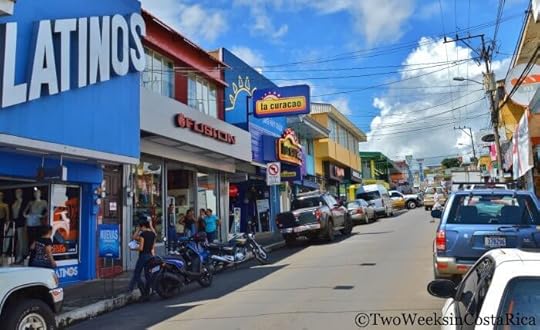
A typical street in San Isidro de El General, filled with shops.
The roads and avenues near the city center are organized loosely into different districts. One area with an abundance of shoe stores, another with multiple banks, and a whole section near the public hospital with different medical specialists and pharmacies. The farther you get from San Isidro center, the more residential the streets become. Homes are modest, usually only one story, but many have lovely gardens and terraces.
What we like most about San Isidro is that it serves as one central location for all the smaller communities in the area. A huge bus station and the Inter-Americana Highway bring people in from even the smallest villages and towns to do business, run errands, or meet up with family and friends. For this reason, city life here is a lot less rushed and everyone is generally very friendly and helpful, more the feeling you get while in the countryside.

Buses coming into town.
Things to Do
Aside from shopping or running errands downtown, there are some unique things to do in or near San Isidro de El General.
Farmers Market: Known locally as the feria, the San Isidro farmers market is the biggest farmers market in the Southern Zone with over 200 vendors selling every kind of fruit and vegetable you can imagine. There are also booths with crafts, meats, fish, homemade breads, jams, and cheeses. You can even buy seedlings, plants, and flowers. The market is held all day Thursdays and until about mid-day Fridays every week. It’s under a gigantic roof so happens rain or shine.
Located at Avenida 6 at Calle 5. Find the school behind the Mega Super grocery store and the feria building is behind that. Parking is available.
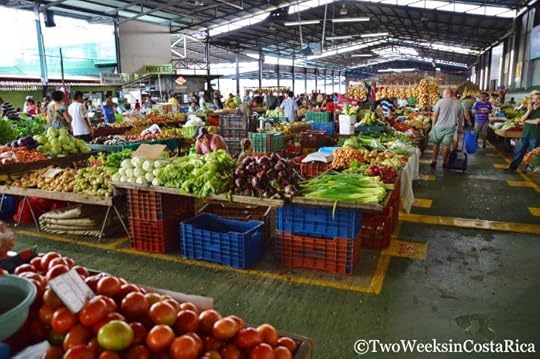
A look inside the feria.
Chirripo National Park: Standing at a whopping 12,533 feet (3,820 meters), Cerro Chirripo is Costa Rica’s tallest mountain. The hike to the top takes you along a steep 10 mile (16 km) trail and is best done in two days with an overnight rest at a ranger station. On clear days it is possible to see both the Pacific Ocean and Caribbean Sea from the summit. This challenging hike is still on our bucket list, but we hope to do it soon!
Cloudbridge Nature Reserve: One of our favorite places to hike in the San Isidro area is Cloudbridge Nature Reserve. This 700 acre (283 hectare) reserve has some rugged trails that lead through beautiful gardens, past gushing waterfalls, and into the thick forest around the base of Mt. Chirripo. The peaceful setting makes a nice day trip and there are lots of amazing birds and animals thanks to its remoteness and lack of foot traffic.

Cloudbridge Nature Reserve
Nauyaca Waterfalls: Located on the road to Dominical, about 30 minutes from San Isidro, is one of the country’s most spectacular waterfalls. The two-tiered Nauyaca drops a total of 200 feet (61 meters) and the lower falls have a beautiful pool for swimming. Read our post Visiting the Beautiful Nauyaca Waterfalls for more info.
Los Cusingos Bird Sanctuary: The former home to one of the world’s best known ornithologists, Dr. Alexander Skutch, Los Cusingos is a special place if you are a birder. This 192 acre (78 hectare) reserve has a network of trails that go around the home and property of the late Skutch. Much of the land is tropical forest and the trails are easy to traverse. Besides spotting lots of bird species, you can also see some ancient petroglyphs (carved rocks) on one of the trails. To plan your visit, read our post Los Cusingos Bird Sanctuary: A Living Memorial for a Famous Naturalist.
For more activities within a short drive of San Isidro de El General, see our post 7 Things to Do in Dominical.
Restaurants
Walking around San Isidro de El General, it seems there is a restaurant on each corner and down every side street. We’ll probably never get to try them all but here are some that we have enjoyed.
La Reina del Valley: The Queen of the Valley. This restaurant overlooking the central park serves up typical food for a great price. It has two stories so you can watch the happenings of town from above too. Go for hearty dishes like gallo pinto (rice and beans with eggs) for breakfast or casados (beef, chicken, or fish with rice and beans and side salads) for lunch.
Urban Farm Cafe: This tiny cafe on the road leading out of town towards Dominical focuses on fresh healthy meals made from local ingredients. They even have lettuce growing inside under their menu board. We’ve tried several of their wraps, salads, and the Mexican bowl, and loved everything. The innovative smoothies are great too.
Pizzeria Stella D’Italia: Good pizza is hard to find in Costa Rica, and we can honestly say that Stella D’Italia has the best we’ve ever tasted here. Marco, the Italian owner, is a passionate chef who uses all the best ingredients. Our favorite is the ricotta pizza. A big thanks to Casey from A Dull Roar for recommending this gem on his blog. Located on Calle 4 near Avienda 1.

One of Marco’s masterpieces!
Cafetería Delicias: This chill coffee shop and restaurant is a great place for breakfast, lunch, or just a tasty snack. It is also located next to the central park so a good place to sip your java, use the Wi-Fi, and watch the people go by. Also a popular expat hangout.
Mi Casita: Another good option for local food like casados, soups, and rice dishes. This small restaurant has locally crafted wooden tables and accents all around. Calle 3 at Avenida 4.
Ricar2: About 10 minutes outside town on the beach road going to Dominical, this restaurant has a stunning view overlooking the valley and San Isidro. Although you might not expect it from the modest exterior, the food here is high quality at an affordable price. The barbeque pork and homemade ravioli dishes hooked us and we’ve been back several times.
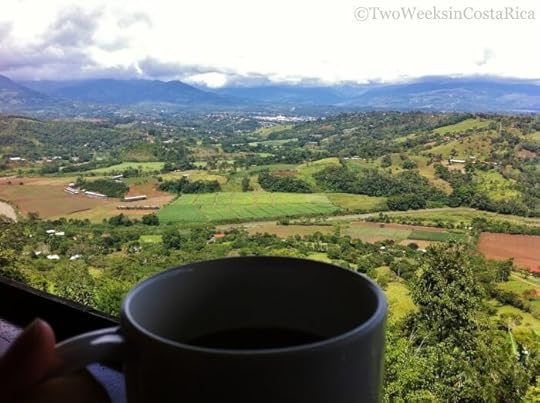
The view from Ricar2.
KapiBlu: KapiBlu is a modern-looking cafe with a big menu. They serve savory sandwiches, burritos, pastas, soups, and snacks like nachos but put a healthy and local touch on everything. The coffee, fresh fruit drinks, and sweets (even cupcakes) are also delicious. Located near the INS building on Calle 1 across from Super Pan.
San Isidro de El General might not be on any tourist map just yet, but this charming city is one you should definitely check out if you are looking to explore Costa Rica’s local culture. It’s also a great place to add to your itinerary if you are searching for that perfect place to retire. Each time we leave, we always seem to comment on what a great day we had. Maybe it’s the convenience of all the shops or the friendly people we bump into on the streets, but we always look forward to going back.
Have you ever been to San Isidro de El General? Let us know you favorite part in the comments below. (Email subscribers, click here to comment online.)
Looking to add more authentic Costa Rica experiences to your trip? Check out these posts:
San Gerardo de Dota: A Hideaway in the Cloud Forest – Best known by birders for the opportunity of see a Resplendent Quetzal, this charming hamlet is also the perfect place to just unwind and enjoy nature.
Guayabo National Monument: An Ancient Pre-Columbian City – Located on the hills of the Turrialba Volcano, this historic sight sheds some light into Costa Rica’s first inhabitants. Like San Isidro, the nearby city of Turrialba has a lot of local character too.
7 Off-the-Beaten-Path Things to Do Near Manuel Antonio – Manuel Antonio is definitely a tourist hotspot but there are some lesser known things to do nearby that will keep you away from the crowds.
Making Organic Chocolate at La Iguana Chocolate – The art of chocolate making is fascinating enough but walking through the farm that grows it, touching, and tasting each element makes this little known tour that much better.
The post San Isidro de El General appeared first on Two Weeks in Costa Rica.
San Isidro del General
Two Weeks in Costa Rica |
Filling a wide valley in the peaceful mountains of Costa Rica’s Southern Zone is San Isidro del General. This small city is bursting with local culture and has an ideal location just an hour from the beach and only minutes from Costa Rica’s tallest mountain, Cerro Chirripo. Although it’s not really on any tourist map, San Isidro del General has attracted many expats over the years with its moderate temperatures, beautiful landscapes, and convenience to shops and services.
We have lived a short drive from San Isidro for a while now. Only recently, after making dozens of doctors’ visits there (read: Having a Baby in Costa Rica), have we gotten to explore what this charming city has to offer. In this post, we’ll share some of our favorite parts.

Location
San Isidro del General is located about 80 miles (130 km) south-southeast of Costa Rica’s capital city of San Jose, right on the Inter-Americana Highway. It lies within the canton of Perez Zeledon, and some people use that as a nickname, calling the city Perez Zeledon or simply Perez. Driving west from San Isidro del General, you can reach the Pacific Coast town of Dominical in just under an hour or the popular beach town of Manuel Antonio in about two hours. The city is backed by the verdant green Talamanca Mountains, and Costa Rica’s highest peak, Mt. Chirripo, is only a short 25 minute drive away.
The Charm of San Isidro del General
Like most Costa Rican cities, San Isidro del General is centered on a square that has a nicely landscaped park and large church. For blocks around this town center, there are shops, restaurants, simple hotels, and just about any type of business you can imagine or need. Candy shops, clothing stores, stationary stores, farm supplies and hardware stores, thrift stores, mechanics, computer repair, dentists, and lawyers are spread out all around town. There is even a McDonalds and Pizza Hut, and a few minutes down the road, a small mall and movie theater.

A typical street in San Isidro del General, filled with shops.
The roads and avenues near the city center are organized loosely into different districts. One area with an abundance of shoe stores, another with multiple banks, and a whole section near the public hospital with different medical specialists and pharmacies. The farther you get from San Isidro center, the more residential the streets become. Homes are modest, usually only one story, but many have lovely gardens and terraces.
What we like most about San Isidro is that it serves as one central location for all the smaller communities in the area. A huge bus station and the Inter-Americana Highway bring people in from even the smallest villages and towns to do business, run errands, or meet up with family and friends. For this reason, city life here is a lot less rushed and everyone is generally very friendly and helpful, more the feeling you get while in the countryside.

Buses coming into town.
Things to Do
Aside from shopping or running errands downtown, there are some unique things to do in or near San Isidro del General.
Farmers Market: Known locally as the feria, the San Isidro farmers market is the biggest farmers market in the Southern Zone with over 200 vendors selling every kind of fruit and vegetable you can imagine. There are also booths with crafts, meats, fish, homemade breads, jams, and cheeses. You can even buy seedlings, plants, and flowers. The market is held all day Thursdays and until about mid-day Fridays every week. It’s under a gigantic roof so happens rain or shine.
Located at Avenida 6 at Calle 5. Find the school behind the Mega Super grocery store and the feria building is behind that. Parking is available.

A look inside the feria.
Chirripo National Park: Standing at a whopping 12,533 feet (3,820 meters), Cerro Chirripo is Costa Rica’s tallest mountain. The hike to the top takes you along a steep 10 mile (16 km) trail and is best done in two days with an overnight rest at a ranger station. On clear days it is possible to see both the Pacific Ocean and Caribbean Sea from the summit. This challenging hike is still on our bucket list, but we hope to do it soon!
Cloudbridge Nature Reserve: One of our favorite places to hike in the San Isidro area is Cloudbridge Nature Reserve. This 700 acre (283 hectare) reserve has some rugged trails that lead through beautiful gardens, past gushing waterfalls, and into the thick forest around the base of Mt. Chirripo. The peaceful setting makes a nice day trip and there are lots of amazing birds and animals thanks to its remoteness and lack of foot traffic.

Cloudbridge Nature Reserve
Nauyaca Waterfalls: Located on the road to Dominical, about 30 minutes from San Isidro, is one of the country’s most spectacular waterfalls. The two-tiered Nauyaca drops a total of 200 feet (61 meters) and the lower falls have a beautiful pool for swimming. Read our post Visiting the Beautiful Nauyaca Waterfalls for more info.
Los Cusingos Bird Sanctuary: The former home to one of the world’s best known ornithologists, Dr. Alexander Skutch, Los Cusingos is a special place if you are a birder. This 192 acre (78 hectare) reserve has a network of trails that go around the home and property of the late Skutch. Much of the land is tropical forest and the trails are easy to traverse. Besides spotting lots of bird species, you can also see some ancient petroglyphs (carved rocks) on one of the trails. To plan your visit, read our post Los Cusingos Bird Sanctuary: A Living Memorial for a Famous Naturalist.
For more activities within a short drive of San Isidro del General, see our post 7 Things to Do in Dominical.
Restaurants
Walking around San Isidro del General, it seems there is a restaurant on each corner and down every side street. We’ll probably never get to try them all but here are some that we have enjoyed.
La Reina del Valley: The Queen of the Valley. This restaurant overlooking the central park serves up typical food for a great price. It has two stories so you can watch the happenings of town from above too. Go for hearty dishes like gallo pinto (rice and beans with eggs) for breakfast or casados (beef, chicken, or fish with rice and beans and side salads) for lunch.
Urban Farm Cafe: This tiny cafe on the road leading out of town towards Dominical focuses on fresh healthy meals made from local ingredients. They even have lettuce growing inside under their menu board. We’ve tried several of their wraps, salads, and the Mexican bowl, and loved everything. The innovative smoothies are great too.
Pizzeria Stella D’Italia: Good pizza is hard to find in Costa Rica, and we can honestly say that Stella D’Italia has the best we’ve ever tasted here. Marco, the Italian owner, is a passionate chef who uses all the best ingredients. Our favorite is the ricotta pizza. A big thanks to Casey from A Dull Roar for recommending this gem on his blog. Located on Calle 4 near Avienda 1.

One of Marco’s masterpieces!
Cafetería Delicias: This chill coffee shop and restaurant is a great place for breakfast, lunch, or just a tasty snack. It is also located next to the central park so a good place to sip your java, use the Wi-Fi, and watch the people go by. Also a popular expat hangout.
Mi Casita: Another good option for local food like casados, soups, and rice dishes. This small restaurant has locally crafted wooden tables and accents all around. Calle 3 at Avenida 4.
Ricar2: About 10 minutes outside town on the beach road going to Dominical, this restaurant has a stunning view overlooking the valley and San Isidro. Although you might not expect it from the modest exterior, the food here is high quality at an affordable price. The barbeque pork and homemade ravioli dishes hooked us and we’ve been back several times.

The view from Ricar2.
KapiBlu: KapiBlu is a modern-looking cafe with a big menu. They serve savory sandwiches, burritos, pastas, soups, and snacks like nachos but put a healthy and local touch on everything. The coffee, fresh fruit drinks, and sweets (even cupcakes) are also delicious. Located near the INS building on Calle 1 across from Super Pan.
San Isidro del General might not be on any tourist map just yet, but this charming city is one you should definitely check out if you are looking to explore Costa Rica’s local culture. It’s also a great place to add to your itinerary if you are searching for that perfect place to retire. Each time we leave, we always seem to comment on what a great day we had. Maybe it’s the convenience of all the shops or the friendly people we bump into on the streets, but we always look forward to going back.
Have you ever been to San Isidro del General? Let us know you favorite part in the comments below. (Email subscribers, click here to comment online.)
Looking to add more authentic Costa Rica experiences to your trip? Check out these posts:
San Gerardo de Dota: A Hideaway in the Cloud Forest – Best known by birders for the opportunity of see a Resplendent Quetzal, this charming hamlet is also the perfect place to just unwind and enjoy nature.
Guayabo National Monument: An Ancient Pre-Columbian City – Located on the hills of the Turrialba Volcano, this historic sight sheds some light into Costa Rica’s first inhabitants. Like San Isidro, the nearby city of Turrialba has a lot of local character too.
7 Off-the-Beaten-Path Things to Do Near Manuel Antonio – Manuel Antonio is definitely a tourist hotspot but there are some lesser known things to do nearby that will keep you away from the crowds.
Making Organic Chocolate at La Iguana Chocolate – The art of chocolate making is fascinating enough but walking through the farm that grows it, touching, and tasting each element makes this little known tour that much better.
The post San Isidro del General appeared first on Two Weeks in Costa Rica.
November 30, 2015
Costa Rica Moving Checklist
Two Weeks in Costa Rica |
Moving abroad can be very stressful. We remember what it was like getting ready for our big move to Costa Rica from Boston in 2013. Selling our stuff and condo, taking care of finances, and figuring out first steps when we arrived were just a few of the many things we needed to do. The only thing that kept us sane through the months of preparation was being organized and having a plan for what to do and when. In this post, we’ll give some guidance on when to start planning your move to Costa Rica and provide a moving checklist to walk you through the process.

When to Start Getting Ready for Your Move
We started taking concrete steps towards moving to Costa Rica a couple of years in advance and recommend this to anyone seriously considering a move themselves. There are a lot of things to plan for, especially financially, that can’t be accomplished in just a few months so the sooner you can start, the better. For example, since we aren’t retired and don’t have a monthly pension or retirement coming in, we knew that we would need quite a bit of savings to get us through until we figured out how to earn enough income through our website and books. We did some budgeting and felt comfortable with the amount we would have by early 2013. That timing also worked out well with our condo, since we knew that spring was the best time of year to sell.
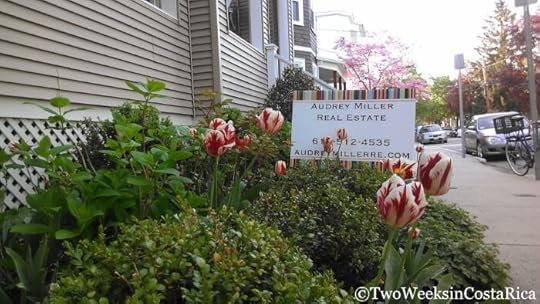
Our old condo in Boston
Your situation might be totally different, but whether you rent or own, are retired or still employed, work for someone else or have your own business, you will probably still benefit from starting early.
On a personal note, we also found that sharing our plans with family and friends early on was very beneficial. A lot of people won’t take you seriously at first and think that moving to Costa Rica is just a dream that probably won’t happen. They might think that for a while, but then as you keep talking about it every time you see them for the next year or more, they’ll start to take it more seriously and be emotionally ready (or at least more so) when the day actually comes.
Moving Checklist
Here’s the list that we used to get ready for our move to Costa Rica.
6 OR MORE MONTHS BEFORE
Packing list. If you’re planning to move with only the basics, begin a list of what you’ll take. Think about what you’ll store, sell, or give away.
Keep in mind that some items are much more expensive or difficult to find in Costa Rica. Here are two posts with more information: Our Eight (or 10) Suitcases; Packing for Your Move to Costa Rica – Advice from Expats.
Shipping. If you’re shipping your stuff, begin researching shipping companies. We didn’t do this so don’t have much advice to give but asking others who have used a shipper in the past is definitely a good idea.
Passports. Make sure you and your family member’s passports are current and not expiring in the near future. Costa Rica requires passports to be valid for at least six months in order to let you into the country. If you still have some time left on them, rest assured that they are easy to renew in Costa Rica through the US embassy in San Jose.
Pets. If you’re moving with pets, begin researching airline policies and what paperwork you’ll need. Keep in mind that some airlines don’t allow pets to travel at certain times of the year (e.g., if it is too hot).
The requirements for bringing a pet into Costa Rica are provided on the Costa Rica Embassy website. For a good first-hand account from someone who brought their dog, check out this link.
Notification list. Start making a list of people to notify about your move. Businesses, banks, distant family members, the IRS, etc. You will add to the list over time.
Residency paperwork. If planning to apply for residency, figure out the process so you know what documents you need to obtain (background check, birth certificates, marriage certificates, etc.). These documents are much easier to get while you’re still in your old country of residence.
Remember that timing is critical as the documents are only valid for a set time from issuance and some take longer to obtain (FBI background check). A good website to start your research is Association of Residents of Costa Rica.
Medical updates. Get physicals, bloodwork, and vaccinations. We got tetanus boosters and the typhoid and Hepatitis A vaccines (typhoid and Hep A are not standard for Costa Rica but we got them because we were planning to travel to other countries in Central America).
Heath/Dental/Eye Insurance
Public health insurance, the Caja, is available only to legal residents. Start thinking about if you’ll pay out of pocket for health care or if you’ll want private or international insurance.
If you have dental insurance and will lose it once you move, get any work you need in the immediate future done but know that it is very affordable in Costa Rica. We’ve found dental work to be cheaper in Costa Rica than what we used to pay in co-pays in the US. Once you get settled, you should have no problem finding a good English-speaking dentist.
For eye glasses and contacts, exams are inexpensive but the glasses themselves are about the same price and contact lenses are more expensive, so stock up at home.
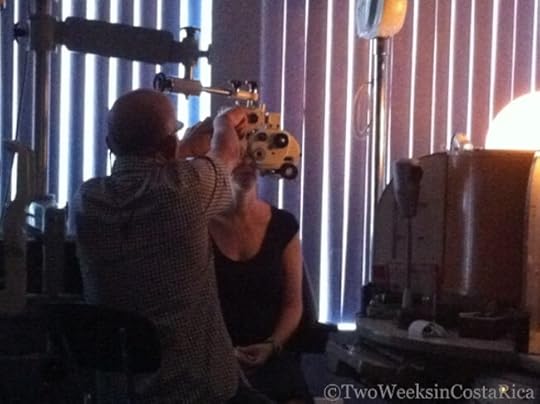
Jenn at the eye doctor in Costa Rica
Credit cards/Bank accounts. Set up accounts that don’t charge for international use.
ATM/debit cards: Most US banks charge fees for using a foreign ATM and an additional fee if you get out local currency (3% or more of total amount in foreign currency conversion fees). For withdrawals from our checking account in the US, we opened a Capital One 360 Account, which provides free ATM withdrawals in foreign countries. We’ve heard Charles Schwab is also good.
Credit Cards: To avoid foreign transaction fees, we ended up going with the Bank of America Travel Rewards and Capital One Venture Rewards cards. Neither of these charge fees for foreign transactions and they’re both rewards-based so we redeem our miles for free airfare.
Legal stuff. Talk with your lawyer/accountant/tax planner about all legal ends that need to be tied up like wills, etc. Think about if your will needs to be updated to reflect changes in assets due to selling your stuff.
Home projects. If planning to sell, finish any projects around the house that will increase your property value.
Selling stuff. Begin selling higher priced items you plan to get rid of so that you’re not scrambling and get nothing for them right before you move. Craigslist and Ebay are two good options.
Read up. Spend some time on blogs and books written by expats who have made the move to Costa Rica themselves. Their first-hand accounts will give you the best insight into what to expect during those first months of your adventure. Here’s a link to a list of books we think you’ll find helpful.
1-2 MONTHS BEFORE
Yard sales. Start organizing your stuff for a yard sale if you’re planning to get rid of a lot. We had two yard sales: one a couple of months out and another right before we put our condo on the market.

Our old condo in shambles during our move
Selling your house. Start talking to a real estate agent if you plan to sell your house. Figure out temporary housing in between the sale and your moving date.
Finalize shipping plans. If you’re using a shipping company, pick a company and start working with them on the details of how the process will work.
Pick your departure date and buy plane tickets.
If you’re planning to bring your stuff in suitcases like we did, make sure your airline doesn’t have a baggage embargo in effect during the time you’ll be traveling.
Don’t rule out first class when considering your options. It might actually be cheaper since many airlines let you have free bags, which can be over the standard weight limit.
If you’re bringing your pet, figure out if you need to buy their tickets simultaneously with yours. Some airlines require this.
Plan your first days in CR. Figure out where you will live, even for only the short term. We stayed in an affordable bed and breakfast for the first week and searched for temporary housing when we arrived. It is typically easier to find housing once you have boots on the ground. Arrange transportation from the airport in Costa Rica to your new place.
Pets. If you’re bringing a pet, be sure that its rabies vaccine is current. Rabies vaccines must be administered between one and 12 months before departure.
More Banking
Contact your banks and ask them to mark your accounts for use in Costa Rica (sometimes checking/debit cards and credit cards must be requested separately). Get their toll-free customer service number for international calls.
Get new cards if any are set to expire soon and checks if you’re about to run out.
Cancel any accounts you don’t want anymore.
Renew driver’s license. If your driver’s license expires soon, renew it. It’s easier to renew when you’re still in-country. This is especially important if you’re planning to stay in Costa Rica on a tourist visa for some time, as you can’t get a Costa Rica driver’s license anymore unless you have residency.
Cancel insurance. Arrange for cancellation of medical, dental, life, and other insurances once you have moved.
Make last minute purchases. Purchase any items that you’ll want to bring (e.g., unlocked cell phone, other electronics that are much more expensive in Costa Rica).
2-4 WEEKS BEFORE
More shipping. Confirm all details with your shipping company.
Pets. If you’re bringing a pet, make an appointment with a licensed vet in your state to receive your international health certificate.
Communication. Set up Skype and/or magicJack so you have a way to communicate with friends and family back home. If you’ll have a good Internet connection, the magicJack app for iPhone works great to call the US and is free.
Software. Download any computer software or files you may want. Your Internet speed might be a lot slower in Costa Rica. Adding music to your computer’s library or converting your CDs into MP3s is also recommended.
Sell your car. Cancel insurance, return license plates and electronic toll devices.
Set up mail forwarding service. We use St. Brendan’s Isle and have been happy with the service. They receive our mail at an address they provided us in Florida and scan it so that we can read it online. We pay for each scan and by weight to have it shipped to Costa Rica or to family or friends who are visiting.
Mail forwarding. Request mail forwarding with the local post office.
Unsubscribe from mailing lists. Cancel magazines that you no longer want, and notify those you wish to keep of your new address.
E-bills. Arrange to begin receiving your bank, credit card statements, and any other bills you’ll still have electronically so that you can pay them online.
More residency. If applying for residency, make sure you have all of your documentation.
Records. Get copies of medical and dental records, including histories of vaccinations.
Banking documents for CR. If planning to open a bank account in Costa Rica, get letters of reference from your US banks. Keep in mind that it is now difficult to open a bank account in Costa Rica unless you are applying for residency or form a Costa Rican corporation.
Notify employer. Give previous employer new address for next year’s tax forms.
2 WEEKS BEFORE
Living arrangements for CR. Finalize plans for where you will be living in Costa Rica.
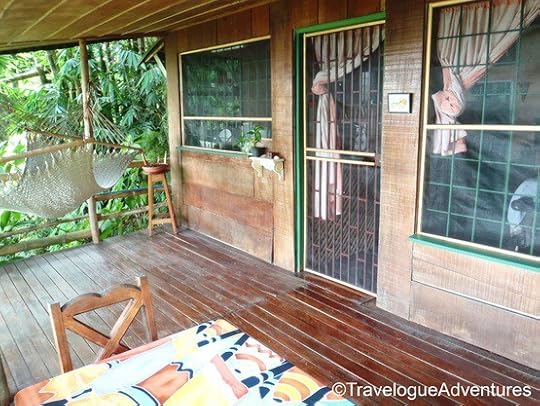
Our first place in Costa Rica, a simple studio in Manuel Antonio
Documents. Make copies of all important documents or store on the Cloud, like Google docs. Put them in a separate location from the originals.
Utilities. Contact utility companies (phone, cable, internet, electric, gas) re: cancellation of service.
Safety deposit box. If you have a safety deposit box, think about if you want to empty it or put anything new in it.
Proof of onward travel. Buy onward tickets to show proof that you will be leaving Costa Rica within 90 days of your arrival to satisfy immigration requirements.
1 WEEK BEFORE
Pack suitcases. Make a list of last-minute items to add the day or two before departure.
Inventory suitcases. We made separate sheets for each suitcase that listed the contents so that we knew what was in each bag. This was really helpful for the first couple of weeks when we were in temporary housing and living out of our suitcases. Taking photos can also help. If you’re shipping your stuff, inventorying is even more important.
Enjoy! Eat your favorite foods and sip your favorite drinks because you might not find the equivalent in Costa Rica. Oh and cheers, this is really happening and it’s going to be an exciting adventure!
This list has been modified from moving checklists on The Real Costa Rica and CostaRica.com.
Have something to add? Let us know in the comments below.
Moving to Costa Rica? Here are some more posts you might find helpful:
FAQs About Moving to Costa Rica: Answers commonly asked questions about obtaining residency, cost of living, internet reliability, etc.
Buying a Car in Costa Rica: The process and our experience buying a car.
Where We’ve Lived in Costa Rica: Our pros and cons on the different places we checked out before settling down in the Southern Zone.
The post Costa Rica Moving Checklist appeared first on Two Weeks in Costa Rica.
November 25, 2015
Arenal 1968 Trail: Hiking Historic Lava Fields
Two Weeks in Costa Rica |
Early one morning in July 1968, an unassuming green mountain in northern Costa Rica suddenly awoke and became the legendary Arenal Volcano. If you are visiting the town of La Fortuna, you’ll be able to see the now ashy gray peak of Arenal from many different spots. One place of particular interest is the 1968 Trail. This series of hiking trails brings you through forested areas and across some of the historic lava fields that buried much of the surrounding jungle during the dramatic eruptions of 1968. In this post, we’ll give you all the details you need to plan your visit.

Location and Access
Arenal Volcano is located 3-4 hours from the main airport in San Jose and about the same distance from the smaller international airport in Liberia. The closest major tourist town is La Fortuna. Access to the 1968 Trail is about 25 minutes from downtown La Fortuna on the western side of the volcano. There is a dirt road off Route 142 and about 1.25 km (3/4 of a mile) down that road, just before Arenal Volcano National Park, you will find the visitors center and parking area. The property is marked with a big sign on the left so you can’t miss it. Admission is $10.
Tip: The dirt road getting to the 1968 Trail is flat and a little bumpy, but 4-wheel drive is not necessary. If you need a car, rent one from Adobe in downtown La Fortuna and make sure to use our Discount Page to save some money.
The Trails at Arenal 1968
The big draw of the Arenal 1968 Trails are the fairly close views of Arenal Volcano. These views give you a look at the old lava flows, now hardened into rock, coming down the slope of the volcano and into the valley. On the edge of the lava field are also a lot of different sized volcanic boulders scattered around. It’s crazy to think about, but these rocks were shot through the air from the volcano’s eruptions at speeds of up to 2,000 km (1,200 miles) per hour. One large rock even left a sizable crater that you can see on the trail. To get to these features, there are a couple of ways to go.
Here is a link to the trail map.

The Bosque 1968 Trail – This trail (the Forest Trail) sets out through some fields and into the thick forest before climbing up to the lava fields and viewpoint. Along the way, it passes Lago Los Patos or Duck Lake, which is about 22 meters (72 feet) deep and was formed when the eruptions took place. This trail is 4.7 km (3 miles) long and is a moderate-to-difficult hike since the terrain has some steep portions as well as lots of roots and rocks. It’s well worth it though if you are looking for birds and other wildlife, since there is a lot hiding in the shade of the forest and around the small lake.
The Colada 1968 Trail – Another way to reach the viewpoint and lava fields is to take the Colada Trail. This is a slightly shorter trail at 4 km (2.4 miles) and is strenuous at times but not as difficult as the Bosque Trail. Colada translates to wash or flow, and this trail is so named because it has the best views of the 1968 flows and the volcano.
Note: All hiking trails around Arenal Volcano are limited to areas surrounding the base for safety reasons. Although there hasn’t been any major activity from the volcano since 2010, it is still considered active and is known to release toxic gases and hot steam near the summit.
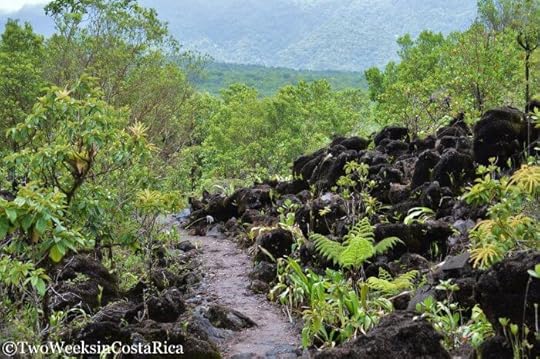
Volcanic boulders on the trail. After nearly 40 years, the jungle is starting to take root once again.
What You’ll See
No matter which trail you take, the good news is that you will end up at the same viewpoints since both trails overlap in the middle. From the highest point, at the Lava Flow Summit, you can normally get a spectacular view of Arenal Volcano. Unfortunately, it became clouded over right as we arrived but we were still able to see parts of it as we hiked.

View of Arenal Volcano from the Lava Flow Summit. Clouded over but still intimidating.
Tip: It’s not uncommon for the top of the volcano to be clouded over, especially during the rainy season (which is when we did the hike). Our best advice is to allow flexibility in your schedule and plan your hike for the first clear day. Read our post about Weather in Costa Rica to do some longer term trip planning.
During our visit, we hiked the Bosque Trail since our good friend Harris, a serious hiker, was with us. We all really enjoyed this trail, mostly because of the flora and fauna that we spotted, but also because it was a great workout. Some of the things we saw were lots of birds, including the Magpie Jay, Tropical King Bird, Montezuma Oropendola, Thick-billed Seed Finch, and an Anhinga in the small lake. We also saw some cool insects like butterflies, leaf-cutter ants, gigantic blue bumble bees, and this crazy beetle.

Near the lava flow and volcano viewing area, we also took in a nice view of Lake Arenal to the west. This is Costa Rica’s largest lake but wasn’t always that way. In 1979, Costa Rica’s electric company built a new hydroelectric dam that tripled the lake’s size. In the process, two towns (Arenal and Tronadora) were relocated to higher ground. To this day, remnants of those old roads and buildings are still at the bottom of the lake.

Lake Arenal, Costa Rica’s largest lake.
The 1968 Trail is an amazing place to hike and learn more about the mighty Arenal Volcano’s ferocious history. Imagine what it was like that historic day back in 1968 when a mountain literally blew its top and released its fury on the nearby jungle and farms. Altogether, 73 people lost their lives in the tragic eruptions reminding us that Mother Nature rules all.
Have you hiked the 1968 Trails near Arenal Volcano? Let us know what you thought in the comments below (Email subscribers click here to post your comment online).
Looking for more to do in the area? Check out these posts:
La Fortuna: What to Expect from Costa Rica’s Most Popular Destination – There is so much to see and do around La Fortuna and that’s why most tourists stop here at least for a few nights. Read this post for our hotel, restaurant, and activity recommendations.
Hiking in Arenal National Park – Located right next to the 1968 Trail, this national park has many of the same features including lava flows, volcanic rocks, and a nice view of Lake Arenal.
Cerro Chato Volcano Hike – Many people don’t realize that the tree-covered hill next to Arenal is also a volcano. This is one of the most challenging hikes in the area and brings you to the top of the dormant Cerro Chato where you can swim in a green crater lake.
The post Arenal 1968 Trail: Hiking Historic Lava Fields appeared first on Two Weeks in Costa Rica.
November 18, 2015
Los Cusingos Bird Sanctuary: A Living Memorial for a Famous Naturalist
Two Weeks in Costa Rica |
Outside the world of ornithology (the study of birds), the name Alexander Skutch might not be at all familiar. But much of what the world knows today about neotropical birds is thanks to this humble naturalist who lived and studied for most of his life in Costa Rica. We recently visited the property, now nature reserve, where Skutch settled and did his research, writing about nature and most specifically birds. In this post, we’ll explain how you can visit the Los Cusingos Bird Sanctuary and also give some background so that you can appreciate this special place even more.

Overview of Los Cusingos Bird Sanctuary
Set in the countryside about 20 minutes outside the small city of San Isidro del General in Costa Rica’s Southern Zone is Los Cusingos Bird Sanctuary or Refugio de Aves Los Cusingos. This 192 acre (78 hectare) reserve once served as the home and outdoor laboratory to the late Dr. Alexander Skutch. In addition to Skutch’s simple home, the property contains a significant parcel of land for conservation and has a network of well-maintained trails that run through the adjacent tropical forest (more on this below).

About Alexander Skutch
Before visiting the sanctuary, it is nice to learn some background on Dr. Skutch. Although the facility does have some information on display as well as some of his books, there is a lot to know about this famous ornithologist and his property.
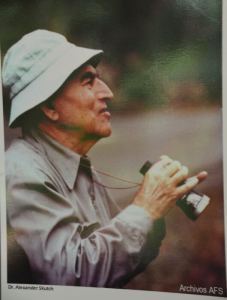
Photo courtesy of Los Cusingos
Skutch first visited the tropics as a trained botanist working for the United Fruit Company on the banana blight, which was prevalent in the 1930s. After traveling around many parts of Central America, Skutch fell in love with the beautiful birds that he saw. He realized, however, that there wasn’t a lot known about many of the species. The scientist in him decided to fix that problem. Looking for an ideal place to study nature and enjoy his new passion for birding, Skutch moved to Costa Rica in 1941 and purchased the property that now makes up the reserve. The name Los Cusingos came from the Spanish name for the Fiery-billed Aracari, a relative of the toucan, which frequented the property (see cover photo above).
Over the next 60 years, Skutch wrote or contributed to over 40 books and more than 200 scientific papers. While some of his work talked about life in the rainforest (A Naturalist in Costa Rica) and even philosophy (Harmony and Conflict in the Living World), most were on bird behavior, covering more than 300 species in great detail. His best known book on birding in Costa Rica is A Guide to the Birds of Costa Rica, which he co-authored with Gary Stiles. Many still consider this to be the best and most detailed resource for birders exploring the country (albeit heavy and somewhat cumbersome).
Check out our picks for some more backpack-friendly Costa Rica wildlife guides here.
Interesting Facts about Dr. Alexander Skutch
Skutch didn’t support the banding of birds to study them. He instead recognized individual birds of the same species by slight differences in plumage and other markings.
The home that Skutch built in the 1940s didn’t get running water until the 1990s. He used the nearby river as a water source until then.
Skutch disliked raptors on his property because they were a danger to other birds. He did, however, welcome the Laughing Falcon because it ate snakes, which are also predators to birds.
Skutch was just eight days from his 100th birthday when he died in 2004.
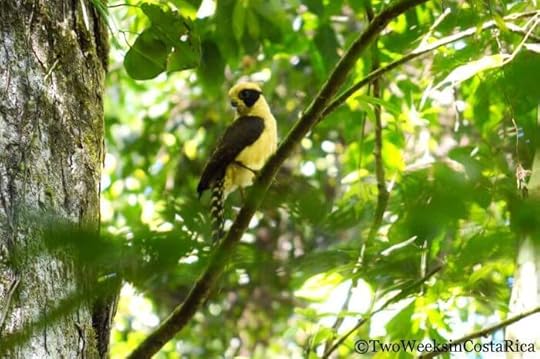
Laughing Falcon
Planning Your Visit to Los Cusingos Bird Sanctuary
Today, Los Cusingos is managed by the Tropical Science Center, which purchased the property after Skutch’s death. The reserve is not well known to tourists so there is a good chance you will have the place all to yourself. When we visited, there was no one but staff on the grounds.
Trails
Here is a photo we took of the trail map to help you plan your visit.
From the entrance and parking area, it is an easy 2 minute walk to the home of the late Dr. Skutch. There are manicured gardens all around, but at the time of our visit, the inside of the house was not open to visitors. We have heard that there are plans in the works for a small museum sometime in the future.
From the house, there are two trails. The Naturalist trail goes farthest into the forest and is about 1 mile (1.6 km) in each direction. This trail is fairly flat and has a gravel base for a good part. There are very tall trees along this stretch, so birds were harder to identify. The last part of the trail leads to some ancient petroglyphs (carved rocks) and is a bit steeper so can be slippery.
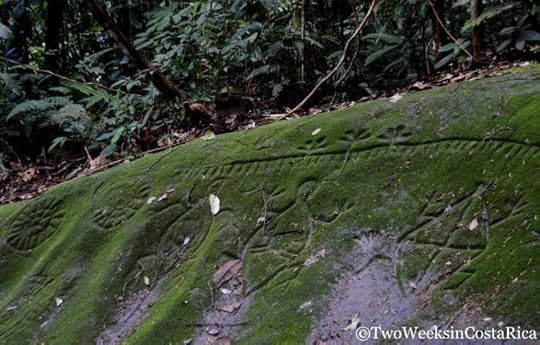
Petroglyphs carved by a pre-Columbian indigenous group
The second trail that starts near the house is the Aves trail. This trail is only about a half mile (0.9 km) in each direction and runs parallel with the Peñas Blancas River. About halfway through the Aves trail, there is a connection to the Naturalist trail that you can use to loop back to the house or continue into the forest. Unfortunately, we didn’t have time to walk this entire trail but think that it might have been better for birdwatching because of its proximity to the river.

Naturalist Trail
What You’ll See
While people mostly visit Los Cusingos for the excellent birding, we actually only counted a handful of birds on our visit because we arrived so late in the morning. On our species list were a Blue-Gray Tanager, Chestnut-Mandibled Toucan, Roadside Hawk, Great Kiskadee, Long-billed Hermit, Black-and-white Warbler, Buff-rumped Warbler, Fasciated Tiger-Heron, and an Orange-billed Sparrow.
Tip: Try to visit at peak birding times, either early morning or later in the afternoon.
Luckily, though, there is a lot more to see. Walking through the property, we saw lots of butterflies as well as some interesting insects like a neon-green Katydid (related to a grasshopper but in the shape of a leaf) and many plants and trees. The sanctuary is located deep in the forest and is very tropical so even just walking along the paths and enjoying the natural surroundings made for a nice day.
Hours
Monday to Saturday, 7:00 a.m. – 4:00 p.m.
Sunday, 7:00 a.m. – 1:00 p.m.
Special hours for birding also may be arranged with advanced reservations.
Cost
$13 adults, $6 children (foreigners)
$3 adults, $2 students, $1 children (nationals)
Guided tours are available for an additional $10. Contact the reserve to make a reservation: (506)-2738-2070 or cusingos@cct.or.cr
Directions
From San Isidro del General: Drive south on Route 2 (Inter-Americana Highway). After the Hotel San Isidro (right side) and Acabados Boston (left side), take a left hand turn onto Route 321 (not marked; medium sized road next to a liquor store). Follow this road, crossing a bridge, and continue until it stops at the end. At the end, take a right hand turn and follow the road, Route 322 (also not marked), until you see signs for Los Cusingos. Take a left at the sign on the corner and go two kilometers (1.2 miles), following more signs until the entrance. From downtown San Isidro the drive time is about 20 minutes.
Have you visited the Los Cusingos Bird Sanctuary? Let us know what you thought in the comments below.
The post Los Cusingos Bird Sanctuary: A Living Memorial for a Famous Naturalist appeared first on Two Weeks in Costa Rica.
November 11, 2015
Best Time to Visit Costa Rica
Two Weeks in Costa Rica |
If you live somewhere that gets cold, you probably can’t wait to plan your getaway to Costa Rica. But when is a good time of year to travel to Central America? In this post, we’ll cover the best (and worst) time to visit Costa Rica based on weather, peak travel times, cost, and more.

Dry and Rainy Seasons
Costa Rica has two distinct seasons: A dry season that runs from December through April, and a rainy season that runs from May through November. The peak travel season when most people visit coincides with the dry season, and conveniently, North America’s and Europe’s winters.
Dry Season: The Safest Time to Visit
We’ll explain why the rainy season really isn’t that bad below, but if you’re one of those people who are very worried about rain ruining your vacation, plan your visit during the dry season. Most areas of the country see little to no rain between mid-December and April, so you don’t have to worry about having to change your plans based on the weather. The dry season is also the best time to visit certain attractions in Costa Rica. Arenal Volcano and Poas Volcano, for example, tend to get fogged over during the rainy months and might be that way during your entire stay. But during the dry season, you’re very likely to get to see them with clear skies.
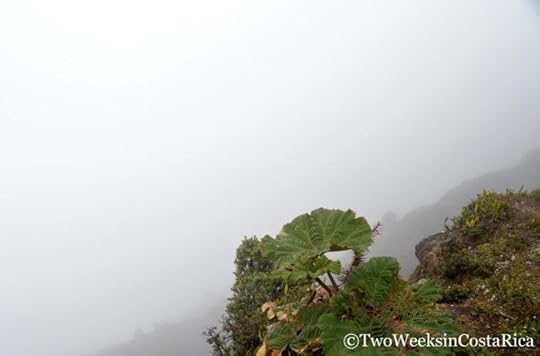
Crater at Poas Volcano when we visited in the rainy season
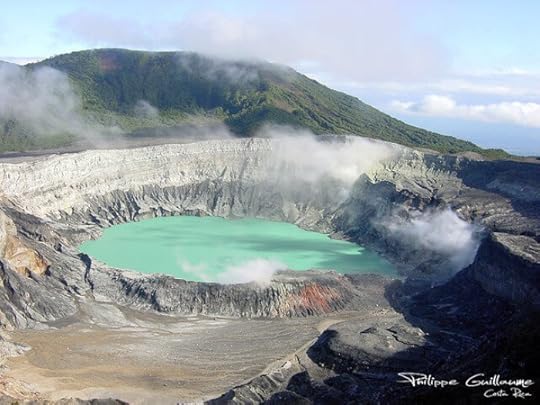
Poas Volcano on a clear day in the dry season. Photo Credit: Philippe Guillaume
Certain hikes are also better in the dry season. If you’re trekking Mt. Chirripo, you’ll have the best chance of seeing both the Caribbean Sea and Pacific Ocean from the top during the dry months. Similarly, the Rio Celeste Waterfall gets muddled with sediment during rainstorms, skewing its characteristic bright blue hue. And the trails at parks and reserves in the wet Southern Zone, like Corcovado National Park, tend to get very muddy during the rainy season. Visibility for snorkeling is also better when there’s less rain and runoff to cloud the water.
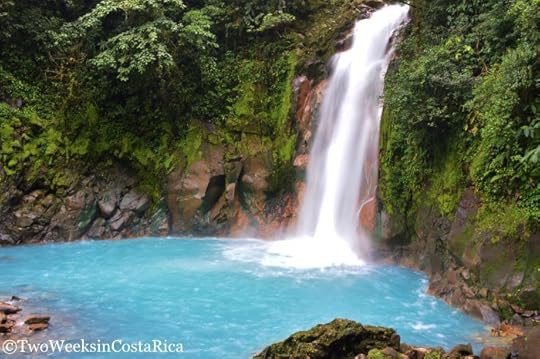
Rio Celeste Waterfall during the dry season
That said, there are some drawbacks to the dry season too. Most importantly, it can be extremely hot at times. We spent a dry season living at the beach in Guanacaste one year and temperatures often peaked in the mid or upper 90s (32°C) during the day. Other areas on the Pacific coast can be just as bad, and places farther to the south (where we live now) tend to be more humid. Because of the heat and lack of rain, it also can get very arid and less tropical in certain parts of the country. Rivers sometimes dry out later in the dry season, which can turn exciting Class IV whitewater rapids into more modest Class II or III. Some waterfalls are the same way, changing from a gush to a mere trickle or even disappearing completely.
Hedge Months of the Rainy Season: A Good Time to Visit if You’re Flexible
If you are somewhat flexible with your plans, consider visiting Costa Rica during the so-called hedge months in between seasons. November to early December and May through August are great times of year to travel. Not only will temperatures be a bit more enjoyable and the rainforest nice and green, you’ll also avoid the big crowds and get better prices. Hotels and rental cars are cheaper, and tour prices are easier to negotiate.
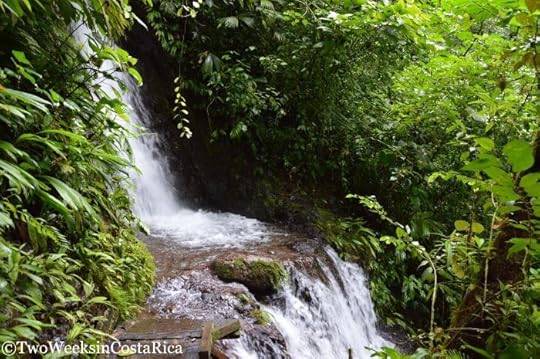
Everything looking nice and green at Rainmaker Nature Reserve in the rainy season
Keep in mind too that you’re not giving up a fantastic vacation by traveling during the rainy season. It seldom rains all day every day during the majority of the season, so as long as you build some flexibility into your itinerary, you should still be able to do everything you want.
TIP: If you’re planning a visit to Costa Rica during the rainy months, take the time to carefully select your destinations. Some regions of the country are wetter than others and best avoided altogether during the low season. Here’s a post all about the weather in Costa Rica, which includes information about how much rain the different regions get over the course of a year: Weather in Costa Rica.
Times to Avoid
Rainiest Months
As we said before, many areas of Costa Rica are very nice during much of the rainy season. But if you have just a week or two to get away, there are certain times of year you’ll want to avoid. The rainiest months in general are September and October. During this time, you might have several days of non-stop rain in a row, which can make it difficult to get out and explore. For this reason, we recommend avoiding travel to Costa Rica during this time for all but the most adventurous travelers. One exception is the Caribbean Coast, which is a great place to go in September and October because it tends to be dry.
Holidays
Other times of year that you may want to avoid are certain holidays. The weeks around Christmas and New Years are the busiest travel times in Costa Rica. Many locals get time off during the week leading up to Christmas, all the way until after New Years, and go on holiday with their families. Not only that, but this is a popular time for tourists to travel as well. The same is true for Semana Santa (Easter week). Many locals get time off during the week leading up to Easter and start the party the weekend before the holiday week. The whole country is busier in general during these times, but beach towns tend to see the most traffic.
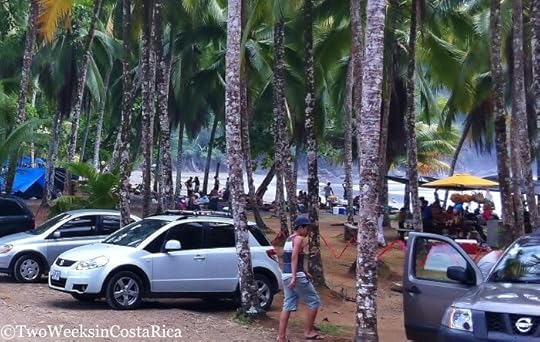
A busy Playa Ventanas over the Easter holiday
Another consideration for those on a budget is that prices are highest during the holidays. You’ll notice, for example, that most hotels charge peak rates and vacation rentals have stricter minimum nightly stays.
TIP: If you’re planning to visit Costa Rica around Christmas or Easter, start early. Hotels and rental cars are usually booked months in advance. You can still have the best picks for lodging though if you plan far enough ahead.
Takeaways
Here are some takeaways about the best time to visit Costa Rica:
Visit during the dry season (December through April) if you’re worried about the rain.
If you’re more flexible, visit during the hedge months of November to early December and May through August to save some money and avoid the crowds.
Avoid the peak rainy season, September and October (unless you’re visiting the Caribbean Coast).
Avoid the weeks around Christmas, New Years, and Easter, especially if you’re on a budget or don’t like crowds.
We hope these tips give you some insight into the best time to visit Costa Rica. Of course, if your options are limited and you can travel only during the busy holiday weeks or rainiest months, there is really no bad time to visit. You can always find a small town to retreat to during peak travel times. And thanks to the country’s many microclimates, you can still find places in Costa Rica with sunshine even during the height of the rainy season that will have you wondering where all the tourists are.
Have a question about when to visit Costa Rica? Ask us below.
Looking for more information to plan your trip? Start here:
Costa Rica: Your Two-Week Itinerary – Detailed guide to the best places to visit and things to do in two weeks.
Cost of Traveling in Costa Rica – What to budget for your trip. Breakdown of costs for hotels, transportation, food, and tours.
Itinerary Help – Planning a trip for the holiday season and want to avoid the crowds? Or are you wondering where to go to avoid the rain? We can design you a custom itinerary. Check out our Itinerary Help page for more information.
The post Best Time to Visit Costa Rica appeared first on Two Weeks in Costa Rica.



